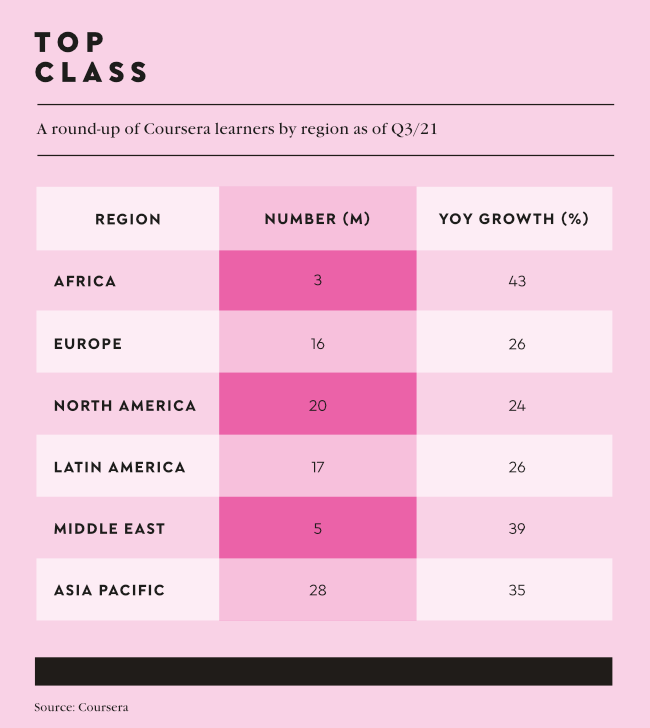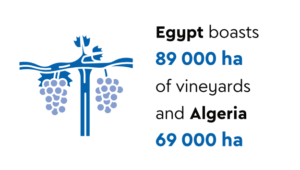Africa’s e-learning market was worth US$2.8 billion in 2022, and it’s anticipated to reach US$5.2 billion by 2028. This pales in comparison to the US, where e-learning market size reached US$110.5 billion in 2022 – nevertheless, this upward trend points to the critical skills development needed for economic growth on the continent.
According to the WEF, online learning platform Coursera recorded 20 million new student registrations in 2021. Regionally, Asia Pacific saw the biggest student presence on the platform, with 28 million new online learners enrolling for 68 million courses, followed by North America, Europe and Latin America. By comparison, just 3 million online learners came from Africa, joining 5 million courses. However, Africa saw the highest growth in both student registrations (up 43%) and course enrolments (up 50%).
While uptake is still far behind more developed regions, Africa’s e-learning market has been experiencing robust gains thanks to rapid digitalisation, growing awareness about the benefits of e-learning, as well as a proliferation of e-learning solutions.
The fact that the continent also has the youngest population in the world is undoubtedly another contributing factor.
‘Africa’s burgeoning youth population is both a challenge and an opportunity,’ says Rebecca Stromeyer, founder and CEO of eLearning Africa, a pan-African network and platform on ICT for Education to showcase, support and improve access to sustainable education solutions.
‘Traditional education infrastructure, including both teaching facilities and student accommodation, is increasingly overwhelmed by this demographic boom. Many students, despite securing admission into tertiary institutions, are left without safe and conducive living spaces, making their academic journey even more challenging.’
Online higher education offers a solution that addresses multiple dimensions of this challenge, she adds. ‘Not only does it bypass the need for physical classroom space, but it also mitigates the pressing issue of student accommodation. More significantly, online education opens doors to world-class quality education. African students can now tap into globally renowned courses, faculties and resources that might previously have been inaccessible. This democratises access to top-tier education, ensuring that students aren’t limited by geographical or infrastructural constraints.’
As digital literacy rates soar and internet accessibility expands, Stromeyer is convinced that a paradigm shift is on the horizon. Online education is set to play a predominant role in tertiary education, she says, facilitating greater access to higher learning and equipping the youth for the demands of the 21st-century labour market. This shift not only addresses educational and infrastructural needs but also promises a quality of education that can rival institutions anywhere in the world.
The staggering potential of online learning to accelerate development on the continent is tempered, however, by challenges both obvious and obscure.
‘Online tertiary education certainly holds much potential, but it is not a one-size-fits-all that can cover all disciplines,’ says Owen Skae, a professor and the director of Rhodes Business School (RBS). ‘For instance, science students still need to do research in labora-tories; medical students have to do hands-on training.’
RBS recently entered into a partnership with eLearnAfrica to develop a virtual learning environment (VLE) to fulfil the school’s goal of enabling its AMBA-accredited MBA to reach into Africa; this will be operational from 2024. The VLE promises to place the most effective online education tools and methods – which have evolved considerably in the wake of the COVID pandemic – at the disposal of students.
‘We’ve all become adept at using a variety of digital means to teach and communicate with our students, whether that be Zoom, Microsoft Teams, or Google Meet,’ says Skae. ‘But online teaching is not simply giving lectures over Zoom. Students must be able to access all the resources needed to make teaching and learning effective. Lecturers have to ensure these resources are available, both synchronously and asynchronously. Whether it is in the form of synchronous lectures, video recordings and/or podcasts, reading material, tutorials and all other mechanisms to ensure it is accessible.
‘Again, it is important to note that there’s no one set way of doing it,’ he says. ‘In the continuum of wholly asynchronous and synchronous, and distance and face-to-face – in class – we’re likely to see blended and hybrid approaches evolve, which will require lecturer development and training, or we run the risk of being stuck in the middle.’
For those who attended traditional universities before the 2010s, it can be nigh impossible to imagine how these institutions might deliver an online education of the same quality as the IRL – to use the parlance of our time – on-campus sort.
There does seem to be some agreement that a hybrid model – in which a portion of the learning requires in-person attendance, while the rest can occur digitally – is best.
‘It depends on the investment made, which has to be significant,’ says Skae. ‘Our view at RBS is that we need to embrace the “phygital” world, by combining the physical and the digital. Hence our MBA will be a hybrid mode of delivery, meaning that there is a compulsory on-campus block, complemented by virtual teaching.’
Stromeyer contends that education quality depends far more on the content, delivery methods and engagement levels than it does on whether that content is delivered in person or not. ‘Online education has the potential to match, if not surpass, the quality of in-person or hybrid models. It offers access to global resources, expertise and diversified methods of learning. However, to achieve this, courses need to be thoughtfully designed with interactive elements, assessments, feedback mechanisms and opportunities for collaborative learning,’ she says.

‘It’s also essential to ensure that educators are adequately trained to facilitate online learning. When these elements are in place, online education can offer a rich, immersive and effective learning experience that is on par with traditional methods.’
Increasingly, students progressing to tertiary institutions in the coming years will be accustomed to digital learning, as well as more individualised engagement and support, as primary and secondary online schools become more established.
‘Every year, we see a significant worldwide growth in online education, whether that’s for school education, tertiary studies or upskilling on the job,’ says Mark Anderson, principal of Koa Academy, an online school that offers small ‘pod’ classes of about eight students per teacher, for Grades 4 to 12. ‘There are fast changes, with massive innovation in the edtech and online education spaces happening all the time. The uptake of online education in Africa in particular is increasing year on year with the expansion of reliable internet access.’
A particular strength of online education is the potential to offer students personalised learning pathways, he says. ‘The traditional education model is to get learners into the classroom with a teacher who presents the content to them in the most standardised way – we call this “teaching to the middle”. This has been based on an assumption that standardised teaching and standardised assessments might ensure that “most” of the learners present in the classroom will learn that lesson. However, over the past few decades, research has clearly shown that this assumption is wrong. In fact, the ways that each of us learn is highly individual; therefore, teaching to the middle means that the fewest possible students actually learn effectively.
‘Online education has fantastic potential to enable students to learn across a variety of education platforms and engage with content in different formats. It also offers more flexibility when it comes to a student learning at their own pace. Well-designed online assessments embedded in the learning pathway can provide learners with rich, real-time feedback so that they can gauge their level of mastery over the content as they progress,’ he says.
‘Online teachers take on the role of being the facilitator of the students’ learning rather than a presenter of content, which enables teachers to unleash their excellence as the experts in how people learn. Properly executed, online education can address a range of problems in our traditional education system.’



















